The main arena of the country. How were Luzhniki updated before the World Cup
It's time to tell how we prepared the Luzhniki Stadium for the World Cup. The INSYSTEMS and LANIT-Integration team got low-current, fire-fighting, multimedia and IT systems. It's actually too early to write memoirs. But I'm afraid when the time comes for this, a new reconstruction will happen, and my material will become obsolete.

I really love the story. I freeze in front of the house of some century there. Sacred delight encompasses when they say that there lived a name (well, well, it was in this tank that the famous writer threw garbage). But to the question of where to live, most, I think, will choose a new home with modern communications and safety features. This is because the standards of our lives over the past 200 years have changed very much. And even 20 years ago, a lot was different.
Therefore, the reconstruction of old buildings and their adaptation to modern use is always more difficult than new construction. In the old dimensions, it is necessary to place modern engineering systems and comply with all building codes. Sometimes such a task is impossible in principle. Then release special specifications. That is, all construction participants shrug their hands: “Could not ...”
When Russia got the right to host the World Cup, no one had any questions about which stadium would be the main one. Of course, the Luzhniki Stadium, where all the major sporting events of our country took place: the legendary Lev Yashin played their last match in the presence of 103 thousand spectators, there was the opening and closing of the Olympics-80 (and for the first time in the USSR they sold phantom and Coca-Cola at 1 I chop for a bottle).
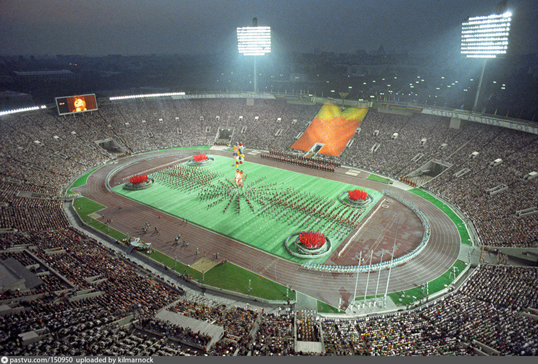
In Luzhniki who forgot, the Champions League final of 2008 was held, and in 2013 the World Championships in Athletics. It seemed that we would have to do almost nothing. Everything is ready and tested in practice.
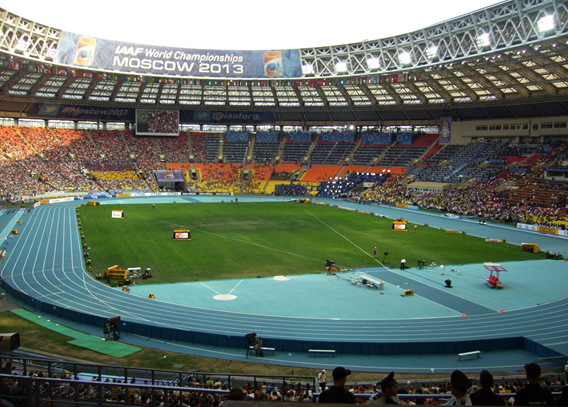
A person far from sports will never understand why it was necessary to spend 24 billion rubles on reconstruction. Only the Big Sports Arena! Apart from the inspection pavilions, the accreditation center, the volunteer center, and on-site parking!
And the answer is this: huge, simply unrealistic money came to sport in general (and to football in the first place). And industry standards in construction have changed. And in the Ministry of Internal Affairs there are new requirements for facilities with a massive presence of people. And something appeared in the FSO and FSB. And the requirements of FIFA (the international football federation, which was the organizer of the World Cup) changed right before our eyes, during inspection visits.
The numbers speak for themselves. 20 years ago, the most expensive football player was worth 25 million euros. It was the Brazilian Ronaldo - a super-mega-star of those years. And last year, 22-year-old Sasha Golovin left for the eminent, but provincial Monaco for 30 million. But the 20-year-old Frenchman Mbappe moved to PSG for 200 million. The most surprising is that these costs pay off.
Through the sale of rights to television broadcasts. The FIFA World Cup was eventually watched by 3.5 billion viewers. For this to happen, an ultramodern broadcast system was needed.

Just a month before the start of the World Cup, I had to urgently re-equip the restaurant in another 15 temporary sky-boxes. Have you multiplied already? Have you already compared the proceeds from the rental of sky-boxes with the cost of the entire reconstruction? (It’s a pity that almost all of this money went to FIFA.)
So: there was none of this in Luzhniki.
And it was hard to see from almost anywhere. Because because of the treadmills and the small inclination of the stands, everything was very, very far away.
At the same time, the city authorities decided to preserve the historical facade of the Luzhniki Stadium. And so began the "reconstruction". When I first entered the arena, the dismantling was already over and the stadium was reminiscent of the scenery from the movie Shirley-Myrli. Remember Vnukovo Airport?
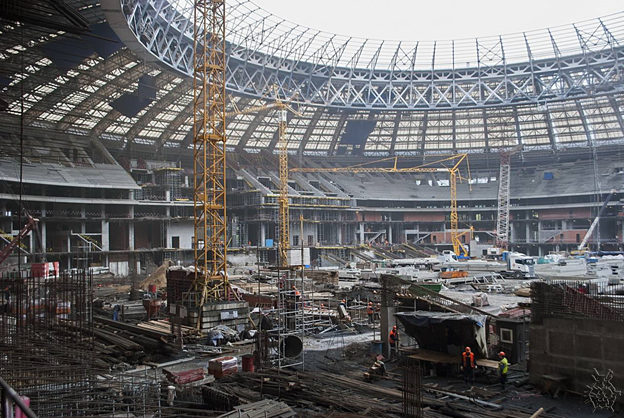
So everything, apart from the historical facade, was redone. As it turned out, not in vain. For example, when they made a “cake” for the field, they dug up a trolley (a surprise from the last reconstruction remained, such a “signature of the master”). There was no waterproofing at all, but there was a direct connection between the stadium's lawn and the Moskva River. Probably to justify the name. "Luzhniki" - it’s from the flood meadows.
The memory is designed so that over time only pleasant memories remain. And photographs helpfully help to resurrect all the bright moments. Here we are taking pictures in the middle of the field (and, by the way, the fire inspector takes pictures, who was allowed to walk around the field so that he forgot about the “jambs” that he just observed during the tests), the first time they turned on the panel (and the second something didn’t want to work), here in the empty bowl of the stadium the “Victory Day” is booming (an hour before that, I realized that everything was gone).

I have long deleted photos of the dusty and at the same time wet hell, which were shown to the curator of the construction site by the Moscow government (according to the schedule, we had to mount and launch IT equipment there).
But even now I remember how difficult and ... scary.
It’s scary because we did a lot for the first time, from the scale, from responsibility (everyone is free to decide who he bears it to). I don’t know what the guys we worked with thought, but I felt like Boriska from the film “Andrei Rublev” by Tarkovsky. He also pretended to be a specialist and agreed to cast the bell, but "the father - the dog - died, but did not pass on the secret." So he did everything on a hunch. And did!
But he was alone, and we have a team. And everyone helped each other, supported, reassured. Not everyone withstood stress. One morning they "lost" the foreman. The phone is not available. The wife says: "In the morning I got into the car and went to work." Through the traffic police began to look for a car. The last time the camera caught him turning from the MKAD into the region (he had nothing to do there). In general, for 3 days no one knew anything, they thought the worst. On the fourth day was found. In Rostov-on-Don. They said the guy had a nervous breakdown.
And our GUI, a reasonable and phlegmatic person in life, somehow grabbed a telephone from his interlocutor and threw him into a concrete wall. Then the fight began, the police arrived, everyone was taken to the department. There they reconciled.
The vertical of management, in which everyone wants to distinguish himself from his superior, works like this. The installer reports to the foreman that he laid 100 meters of cable before lunch. The foreman realizes that there is still half a day ahead and reports to the foreman that we will lay 200 meters today (the stadium is very large, the foreman did not recognize that his worker was thrown into the warehouse after lunch). The foreman orders to expedite the work and reports to the head of the site that we will push and lay 300 meters before the end of the day. And then it’s clear. As rivulets flow into the river, so this embellished information goes higher and higher. And reality is becoming more and more beautiful.
And the Mayor is informed that the stadium will be commissioned in 3 months, that is, six months ahead of schedule. The mayor speaks on television against the backdrop of a green field and orders to begin comprehensive testing of all systems. To finish in just 3 months. And leaves. And we stay and listen to Victory Day.
And then we go to the meeting to discuss what to do now. The construction manager proposed a completely new and absolutely brilliant solution: “Add people, organize a second shift” (this is probably how Stalin told Zhukov during the defense of Moscow in 1941).
I must say that the construction at this moment really came to an end. And the closer to him, the more qualified people are required. There are always few of them. The solution came by itself: let these same people work in two shifts. The first time I saw people a) come to work at 9:00, b) work until the next morning, c) present work to the inspector, d) until 17:00 they eliminate comments and go home, e) ... come to work at 9 : 00 a.m.
It’s good that they did not work in this mode for long. The general contractor one day simply turned off the electricity at night. They did not agree on the rate of the night watchman.
Or here's another story. To collect and start the fire alarm, it is necessary to mount the fire detectors on the ceiling, tie them into a loop like bulbs in a Christmas garland and connect them to the central station (there are up to 256 devices in a loop, and there are so many loops themselves to protect all rooms). So we go into the locker room of the teams, but there is no ceiling. And there is a comprehensive test plan. Think we ripped it off? No matter how! The picture was very funny: a large hall, and sensors hang from the ceiling. A bit like fishing hooks in terms of a diver.
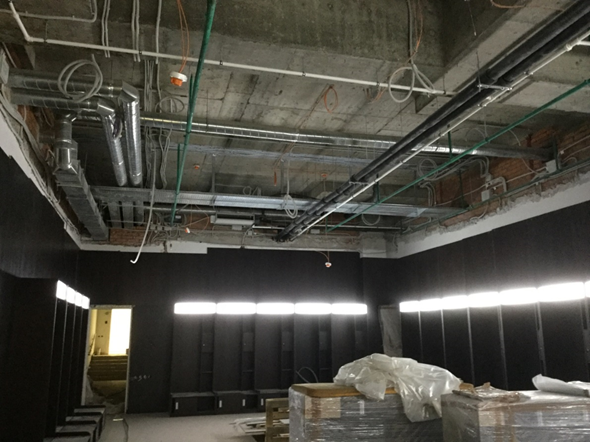
Today, BIM design has become the industry standard. This is not just a three-dimensional model, but also a specification of equipment and materials, which is generated and adjusted automatically. Of course, everything is more complicated in nature than on a computer screen: somewhere, they made a mistake with height, somewhere a beam appeared, somewhere new requirements came from the customer, and installation was already done, etc. But in general, when all the designers work in a single information space, errors are an order of magnitude less.
But we and the designers of allied companies began to design Luzhniki in 2014, when BIM models were still exotic.
The peculiarity of the stadium is that with not the largest area of the under-stands (165 thousand square meters) there is nothing typical there. This is not a high-rise tower, where 45 of the 50 floors are the same.
But still, the stadium is very large and very saturated with engineering systems. Therefore, there were many contractors. And each has its own production culture, accuracy, and simply human qualities. Plus, during the construction, I had to make many changes to the projects. The result is easy to guess.
Here is one example. The fire automatics system is complicated in that 3 groups of people participate in its installation and commissioning (the picture does not change much even if they work in the same company): the ventilators mount valves (smoke exhaust, air inlet, fire retardants) and their actuators , electricians supply power to them, and low-voltage people connect control cables. Everyone does this in accordance with their project. In Luzhniki, where there are about 4,000 such devices, the three subcontractors in the projects had a different number of devices, and they were located in different places behind the suspended ceiling. How did we solve this problem? That's right: people added.
Among other things, we had to mount turnstiles around the entire perimeter of the stadium. This was the second security circuit (the first was mounted at the entrance to the territory, there they carried out a personal search and verification of Fan ID). And we first decided to put ordinary turnstiles there. But Luzhnikov’s employees explained that there are people who jump even full-height turnstiles. So at the entrance to the arena appeared structures resembling anti-tank hedgehogs with visors.
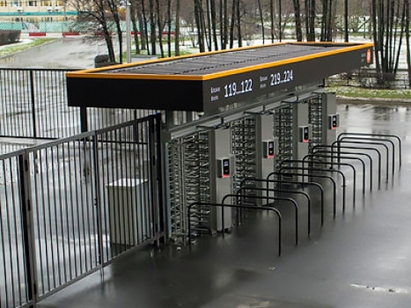
The turnstiles themselves were also mounted not without adventure. First, we chose the installation sites for a long time, tried on for a long time (so as not to get to the already laid underground utilities), waited a long time for the foundations to be poured out to us, cut the gates for cable laying, mounted the hatches ... And then one morning we arrive and we see that the whole area around the stadium is asphalted. And under the fresh asphalt all our markings, strobes and hatches remained. In general, the square became flat, like ... (do you remember Zhvanetsky's “The Demoman's Tale”?)
We sit, think what to do. But then the construction manager came and said: “You have metal hatches. You can try to find them with a mine detector. ”
Or another story. The location of fire protection equipment (sensors, speakers, buttons, strobe lights, indicators) is regulated by SNiPs. Well, we installed them and put them into operation. But security experts at Luzhnikov explained that a crowd of drunken fans would root them and press the buttons of all manual call points. We had to carry out “anti-vandal events” (this is the section of the project): they raised something higher, took something to the bars, and something ... I won’t say it.
And video surveillance is our special pride. Probably, anywhere in the world there is no such density of cameras per square meter. There are 2000 of them at the stadium, not counting the special video surveillance system for spectators, with the help of which it is guaranteed to recognize a person from the opposite rostrum. And they are all integrated into the Safe City system. From the situation center of the stadium (also our work) you can see not only all the images from the cameras of the arena, but also the territory, but from special workstations - of the whole city.
Televisions delivered a lot of trouble, which we installed at the stadium for more than 1000 pieces. We put 3 of them into the VIP box, because the visor above it covered the scoreboard, and a duplicate “picture” was displayed on these TVs.
It turns out that passions in the VIP box boil no worse than on the fan platform! For example, the king of Spain during a match with Russia broke the TV. They say that he accidentally hit ... A chair, probably.
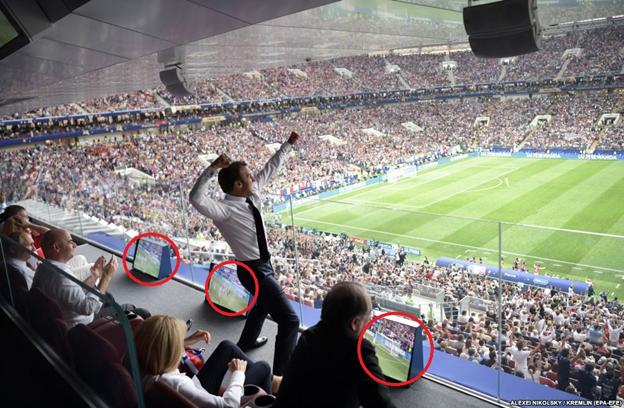
Like Tarkovsky’s in Andrei Rublev, it all ended well. And Messi came to the opening match, and the Russian team won both of their matches in Luzhniki, and the final was a success. And at the very end there was that terrible rain at the award ceremony (directly, “Master and Margarita”) and a lonely umbrella over the VIP platform.

Remember, several years ago in Australia they announced an international competition for the best work in the world? You had to live on a tropical island, feed the giant turtles and blog on the Internet. And to receive for this somewhere around 100 thousand dollars a year.
But I think that the best work in the world (in Moscow, for sure) is for those guys who cut the lawn in Luzhniki every morning.
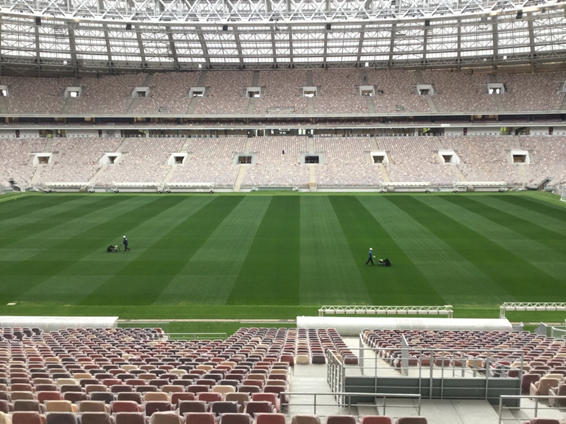

Reconstruction or new construction
I really love the story. I freeze in front of the house of some century there. Sacred delight encompasses when they say that there lived a name (well, well, it was in this tank that the famous writer threw garbage). But to the question of where to live, most, I think, will choose a new home with modern communications and safety features. This is because the standards of our lives over the past 200 years have changed very much. And even 20 years ago, a lot was different.
Therefore, the reconstruction of old buildings and their adaptation to modern use is always more difficult than new construction. In the old dimensions, it is necessary to place modern engineering systems and comply with all building codes. Sometimes such a task is impossible in principle. Then release special specifications. That is, all construction participants shrug their hands: “Could not ...”
When Russia got the right to host the World Cup, no one had any questions about which stadium would be the main one. Of course, the Luzhniki Stadium, where all the major sporting events of our country took place: the legendary Lev Yashin played their last match in the presence of 103 thousand spectators, there was the opening and closing of the Olympics-80 (and for the first time in the USSR they sold phantom and Coca-Cola at 1 I chop for a bottle).

In Luzhniki who forgot, the Champions League final of 2008 was held, and in 2013 the World Championships in Athletics. It seemed that we would have to do almost nothing. Everything is ready and tested in practice.

A person far from sports will never understand why it was necessary to spend 24 billion rubles on reconstruction. Only the Big Sports Arena! Apart from the inspection pavilions, the accreditation center, the volunteer center, and on-site parking!
And the answer is this: huge, simply unrealistic money came to sport in general (and to football in the first place). And industry standards in construction have changed. And in the Ministry of Internal Affairs there are new requirements for facilities with a massive presence of people. And something appeared in the FSO and FSB. And the requirements of FIFA (the international football federation, which was the organizer of the World Cup) changed right before our eyes, during inspection visits.
The numbers speak for themselves. 20 years ago, the most expensive football player was worth 25 million euros. It was the Brazilian Ronaldo - a super-mega-star of those years. And last year, 22-year-old Sasha Golovin left for the eminent, but provincial Monaco for 30 million. But the 20-year-old Frenchman Mbappe moved to PSG for 200 million. The most surprising is that these costs pay off.
Through the sale of rights to television broadcasts. The FIFA World Cup was eventually watched by 3.5 billion viewers. For this to happen, an ultramodern broadcast system was needed.
- At the expense of tickets (they showed me tickets for the World Cup final match, the nominal price of which was 800 thousand rubles).
- Due to the widespread sale of snacks, drinks, souvenirs. Follow the logic: in order to sell a lot of goods in a limited area, a lot of rich buyers should gather in this place. What needs to be done to get them there? They should be interested, fun, comfortable and safe.
- By selling ... prestige and exclusivity. The most “major” seats in the stadium are in sky-boxes. These are rooms located at the most convenient height along the entire ring of stands. Each is designed for 14 people. It has its own bathroom and kitchen, 2 large TVs. And access to your own beach. Sorry - the podium. Renting a sky box for 7 World Cup matches cost $ 2.5 million. Looking ahead, I’ll say that they were built by 102, and it turned out to be few.

Just a month before the start of the World Cup, I had to urgently re-equip the restaurant in another 15 temporary sky-boxes. Have you multiplied already? Have you already compared the proceeds from the rental of sky-boxes with the cost of the entire reconstruction? (It’s a pity that almost all of this money went to FIFA.)
So: there was none of this in Luzhniki.
And it was hard to see from almost anywhere. Because because of the treadmills and the small inclination of the stands, everything was very, very far away.
At the same time, the city authorities decided to preserve the historical facade of the Luzhniki Stadium. And so began the "reconstruction". When I first entered the arena, the dismantling was already over and the stadium was reminiscent of the scenery from the movie Shirley-Myrli. Remember Vnukovo Airport?

So everything, apart from the historical facade, was redone. As it turned out, not in vain. For example, when they made a “cake” for the field, they dug up a trolley (a surprise from the last reconstruction remained, such a “signature of the master”). There was no waterproofing at all, but there was a direct connection between the stadium's lawn and the Moskva River. Probably to justify the name. "Luzhniki" - it’s from the flood meadows.
How it all began
The memory is designed so that over time only pleasant memories remain. And photographs helpfully help to resurrect all the bright moments. Here we are taking pictures in the middle of the field (and, by the way, the fire inspector takes pictures, who was allowed to walk around the field so that he forgot about the “jambs” that he just observed during the tests), the first time they turned on the panel (and the second something didn’t want to work), here in the empty bowl of the stadium the “Victory Day” is booming (an hour before that, I realized that everything was gone).

I have long deleted photos of the dusty and at the same time wet hell, which were shown to the curator of the construction site by the Moscow government (according to the schedule, we had to mount and launch IT equipment there).
But even now I remember how difficult and ... scary.
It’s scary because we did a lot for the first time, from the scale, from responsibility (everyone is free to decide who he bears it to). I don’t know what the guys we worked with thought, but I felt like Boriska from the film “Andrei Rublev” by Tarkovsky. He also pretended to be a specialist and agreed to cast the bell, but "the father - the dog - died, but did not pass on the secret." So he did everything on a hunch. And did!
But he was alone, and we have a team. And everyone helped each other, supported, reassured. Not everyone withstood stress. One morning they "lost" the foreman. The phone is not available. The wife says: "In the morning I got into the car and went to work." Through the traffic police began to look for a car. The last time the camera caught him turning from the MKAD into the region (he had nothing to do there). In general, for 3 days no one knew anything, they thought the worst. On the fourth day was found. In Rostov-on-Don. They said the guy had a nervous breakdown.
And our GUI, a reasonable and phlegmatic person in life, somehow grabbed a telephone from his interlocutor and threw him into a concrete wall. Then the fight began, the police arrived, everyone was taken to the department. There they reconciled.
Add people
The vertical of management, in which everyone wants to distinguish himself from his superior, works like this. The installer reports to the foreman that he laid 100 meters of cable before lunch. The foreman realizes that there is still half a day ahead and reports to the foreman that we will lay 200 meters today (the stadium is very large, the foreman did not recognize that his worker was thrown into the warehouse after lunch). The foreman orders to expedite the work and reports to the head of the site that we will push and lay 300 meters before the end of the day. And then it’s clear. As rivulets flow into the river, so this embellished information goes higher and higher. And reality is becoming more and more beautiful.
And the Mayor is informed that the stadium will be commissioned in 3 months, that is, six months ahead of schedule. The mayor speaks on television against the backdrop of a green field and orders to begin comprehensive testing of all systems. To finish in just 3 months. And leaves. And we stay and listen to Victory Day.
And then we go to the meeting to discuss what to do now. The construction manager proposed a completely new and absolutely brilliant solution: “Add people, organize a second shift” (this is probably how Stalin told Zhukov during the defense of Moscow in 1941).
I must say that the construction at this moment really came to an end. And the closer to him, the more qualified people are required. There are always few of them. The solution came by itself: let these same people work in two shifts. The first time I saw people a) come to work at 9:00, b) work until the next morning, c) present work to the inspector, d) until 17:00 they eliminate comments and go home, e) ... come to work at 9 : 00 a.m.
It’s good that they did not work in this mode for long. The general contractor one day simply turned off the electricity at night. They did not agree on the rate of the night watchman.
Or here's another story. To collect and start the fire alarm, it is necessary to mount the fire detectors on the ceiling, tie them into a loop like bulbs in a Christmas garland and connect them to the central station (there are up to 256 devices in a loop, and there are so many loops themselves to protect all rooms). So we go into the locker room of the teams, but there is no ceiling. And there is a comprehensive test plan. Think we ripped it off? No matter how! The picture was very funny: a large hall, and sensors hang from the ceiling. A bit like fishing hooks in terms of a diver.

Swan, 3 crayfish and 5 pike
Today, BIM design has become the industry standard. This is not just a three-dimensional model, but also a specification of equipment and materials, which is generated and adjusted automatically. Of course, everything is more complicated in nature than on a computer screen: somewhere, they made a mistake with height, somewhere a beam appeared, somewhere new requirements came from the customer, and installation was already done, etc. But in general, when all the designers work in a single information space, errors are an order of magnitude less.
But we and the designers of allied companies began to design Luzhniki in 2014, when BIM models were still exotic.
The peculiarity of the stadium is that with not the largest area of the under-stands (165 thousand square meters) there is nothing typical there. This is not a high-rise tower, where 45 of the 50 floors are the same.
But still, the stadium is very large and very saturated with engineering systems. Therefore, there were many contractors. And each has its own production culture, accuracy, and simply human qualities. Plus, during the construction, I had to make many changes to the projects. The result is easy to guess.
Here is one example. The fire automatics system is complicated in that 3 groups of people participate in its installation and commissioning (the picture does not change much even if they work in the same company): the ventilators mount valves (smoke exhaust, air inlet, fire retardants) and their actuators , electricians supply power to them, and low-voltage people connect control cables. Everyone does this in accordance with their project. In Luzhniki, where there are about 4,000 such devices, the three subcontractors in the projects had a different number of devices, and they were located in different places behind the suspended ceiling. How did we solve this problem? That's right: people added.
Sad and funny
Among other things, we had to mount turnstiles around the entire perimeter of the stadium. This was the second security circuit (the first was mounted at the entrance to the territory, there they carried out a personal search and verification of Fan ID). And we first decided to put ordinary turnstiles there. But Luzhnikov’s employees explained that there are people who jump even full-height turnstiles. So at the entrance to the arena appeared structures resembling anti-tank hedgehogs with visors.

The turnstiles themselves were also mounted not without adventure. First, we chose the installation sites for a long time, tried on for a long time (so as not to get to the already laid underground utilities), waited a long time for the foundations to be poured out to us, cut the gates for cable laying, mounted the hatches ... And then one morning we arrive and we see that the whole area around the stadium is asphalted. And under the fresh asphalt all our markings, strobes and hatches remained. In general, the square became flat, like ... (do you remember Zhvanetsky's “The Demoman's Tale”?)
We sit, think what to do. But then the construction manager came and said: “You have metal hatches. You can try to find them with a mine detector. ”
Or another story. The location of fire protection equipment (sensors, speakers, buttons, strobe lights, indicators) is regulated by SNiPs. Well, we installed them and put them into operation. But security experts at Luzhnikov explained that a crowd of drunken fans would root them and press the buttons of all manual call points. We had to carry out “anti-vandal events” (this is the section of the project): they raised something higher, took something to the bars, and something ... I won’t say it.
And video surveillance is our special pride. Probably, anywhere in the world there is no such density of cameras per square meter. There are 2000 of them at the stadium, not counting the special video surveillance system for spectators, with the help of which it is guaranteed to recognize a person from the opposite rostrum. And they are all integrated into the Safe City system. From the situation center of the stadium (also our work) you can see not only all the images from the cameras of the arena, but also the territory, but from special workstations - of the whole city.
Televisions delivered a lot of trouble, which we installed at the stadium for more than 1000 pieces. We put 3 of them into the VIP box, because the visor above it covered the scoreboard, and a duplicate “picture” was displayed on these TVs.
It turns out that passions in the VIP box boil no worse than on the fan platform! For example, the king of Spain during a match with Russia broke the TV. They say that he accidentally hit ... A chair, probably.

Like Tarkovsky’s in Andrei Rublev, it all ended well. And Messi came to the opening match, and the Russian team won both of their matches in Luzhniki, and the final was a success. And at the very end there was that terrible rain at the award ceremony (directly, “Master and Margarita”) and a lonely umbrella over the VIP platform.

The best work in the world
Remember, several years ago in Australia they announced an international competition for the best work in the world? You had to live on a tropical island, feed the giant turtles and blog on the Internet. And to receive for this somewhere around 100 thousand dollars a year.
But I think that the best work in the world (in Moscow, for sure) is for those guys who cut the lawn in Luzhniki every morning.

